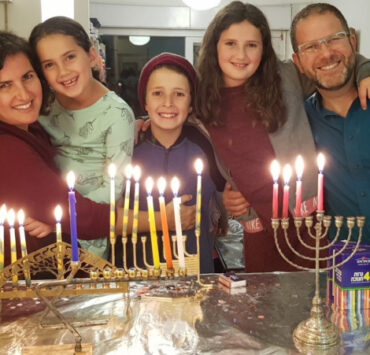
Introduction to The Dreidel Game
A dreidel is a spinning top with four sides, each bearing a Hebrew letter. It serves a central role in a beloved children’s game played during Hanukkah. The game entails spinning the dreidel and placing bets on the Hebrew letter that will appear when the top comes to a stop. Typically, children engage in this game to win a pot of gelt—chocolate coins wrapped in gold-colored foil. However, variations exist, and participants may wager for candy, nuts, raisins, or other small treats. The term “dreidel” originates from the Yiddish language, derived from the German word “drehen,” meaning “to turn.”
What is a Dreidel?
The dreidel, a traditional Hanukkah toy for children, is a spinning top with four sides, each adorned with a Hebrew letter: נ (Nun), ג (Gimmel), ה (Hay), or ש (Shin). These letters collectively represent the Hebrew expression “Nes Gadol Haya Sham,” signifying “a great miracle happened there.”
Read: A Delightful Latkes Recipe
While ancient dreidels were crafted from clay, modern versions are commonly fashioned from materials such as wood or plastic.

Dreidel Game Instructions and Rules
The dreidel game is suitable for any number of players, commonly enjoyed by children but open to participants of all ages.
Getting Started To engage in the game, you’ll need:
- Ten to fifteen pieces of Hanukkah gelt or candy per player
- One dreidel
- A solid surface, like a table or wooden flooring
Players gather around a table or sit in a circle on the floor. Each participant receives an equal number of gelt pieces or candy, typically ranging from ten to fifteen. At the start of each round, each player contributes one piece of gelt to the central “pot.”
Playing the Game Taking turns, players spin the dreidel, and each Hebrew letter holds specific significance in the game:
- Nun, representing “nichts” or “nothing” in Yiddish, means the spinner takes no action if it lands facing up.
- Gimmel, signifying “ganz” or “everything” in Yiddish, results in the spinner acquiring the entire pot when facing up.
- Hey, equivalent to “halb” or “half” in Yiddish, grants the spinner half of the pot upon landing facing up.
- Shin, corresponding to “shtel” or “put in” in Yiddish, and Pey, meaning “pay,” both prompt the player to add a game piece to the pot if facing up.
Players exit the game when they run out of game pieces.
Origins of the Dreidel
According to Jewish tradition, a game akin to the dreidel gained popularity during the reign of Antiochus IV in second-century BCE Syria. In a time when practicing their religion openly was restricted, Jews devised a clever strategy. When assembling to study the Torah, they brought a top with them. If soldiers unexpectedly appeared, they would swiftly conceal their religious texts, pretending to engage in a gambling game with the spinning top.
The Hebrew Letters on a Dreidel
A dreidel displays a single Hebrew letter on each side. Beyond the borders of Israel, these letters include נ (Nun), ג (Gimmel), ה (Hay), and ש (Shin), collectively representing the Hebrew expression “Nes Gadol Haya Sham,” which translates to “A great miracle happened there [in Israel].”
This miraculous event traces back to the Hanukkah oil miracle, a tradition dating back approximately 2200 years. The narrative recounts how, during a period when a king from Damascus compelled Jews to worship Greek gods, Jewish rebels, striving for their freedom, reclaimed the Holy Temple in Jerusalem. In their efforts to rededicate the temple, they discovered only enough oil to sustain the flames for one night. Remarkably, the oil endured for eight days, affording them ample time to procure more oil and maintain the eternal flame.
The Dreidel Song
Composed during the Tin Pan Alley era in 1927 by New York musician Samuel Goldfarb, the now-popular Dreidel Song didn’t immediately gain widespread recognition. However, in the 1950s, as Jewish culture started to integrate more into mainstream consciousness, the song soared in popularity. Presently, it stands as a holiday classic, even though it isn’t directly related to the act of playing the dreidel game. Over time, various renditions of the lyrics have emerged, and the song has been recorded in numerous musical styles.
The original dreidel song lyrics are as follows:
Well
I have a little dreidel
I made it out of clay
And when it’s dry and ready
Then, dreidel I shall play
Oh, dreidel, dreidel, dreidel
I made it out of clay
And when it’s dry and ready
Then, dreidel I will play
It has a lovely body
With legs so short and thin
And when it gets all tired
It drops and I will win
Oh, dreidel, dreidel, dreidel
I made it out of clay
And when it’s dry and ready
Then, dreidel I will play
My dreidel is so playful
It loves to dance and spin
A happy game of dreidel
Come play now, let’s begin
Oh, dreidel, dreidel, dreidel
I made it out of clay
And when it’s dry and ready
Then, dreidel I will play
Frequently Asked Questions (FAQ) about Dreidel
Q1: What is a dreidel?
A1: A dreidel is a four-sided spinning top with Hebrew letters on each side. It is a traditional toy used during the Jewish festival of Hanukkah.
Q2: How do you play the dreidel game?
A2: Players take turns spinning the dreidel, and each Hebrew letter on the top corresponds to a different action in the game. The letters are Nun, Gimmel, Hey, and Shin, representing different outcomes like doing nothing, winning the entire pot, receiving half the pot, or adding to the pot.
Q3: What do the Hebrew letters on the dreidel mean?
A3: The letters Nun, Gimmel, Hey, and Shin stand for the Hebrew phrase “Nes Gadol Haya Sham,” meaning “A great miracle happened there [in Israel].” They relate to the Hanukkah miracle of the oil lasting eight days.
Q4: Can anyone play the dreidel game?
A4: Yes, the dreidel game is suitable for players of all ages. While it is often played by children, it can be enjoyed by people of any age.
Q5: What do you need to play the dreidel game? A5: To play, you’ll need ten to fifteen pieces of Hanukkah gelt or candy per player, one dreidel, and a hard surface like a table or floor.
Q6: What is the significance of Hanukkah gelt in the game?
A6: Hanukkah gelt, usually chocolate coins, is often used as the currency in the dreidel game. Players contribute a piece to the central pot at the beginning of each round, and winners may take the entire pot.
Q7: Are there variations of the dreidel song?
A7: Yes, there are various versions of the Dreidel Song, a popular Hanukkah tune. It was written in 1927 and has been recorded in many musical styles, becoming a holiday classic.
Q8: What is the origin of the dreidel game?
A8: The dreidel game is believed to have roots in the time of Antiochus IV during the second century BCE when Jews, unable to openly practice their religion, used the spinning top as a cover for studying the Torah.
Q9: Is the dreidel game associated with any particular denomination of Judaism? A9: No, the dreidel game is a widely celebrated tradition among Jews of various denominations and is not specific to any particular group.
Q10: Can you play the dreidel game outside of the Hanukkah season?
A10: While the dreidel game is strongly associated with Hanukkah, there is no strict rule against playing it at other times of the year. However, it is most commonly played during the Hanukkah festival.
Check out some of our amazing web stories below.
Related posts:
What's Your Reaction?
One of my friends once said, I am in love with words and a zoned out poser... well, I will keep it the way it has been said! Besides that you can call me a compulsive poet, wanna-be painter and an amateur photographer











